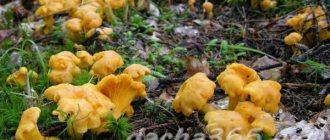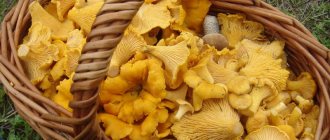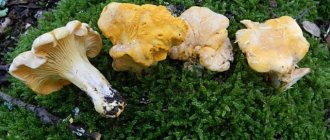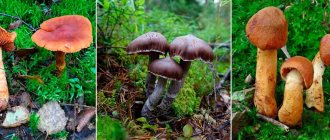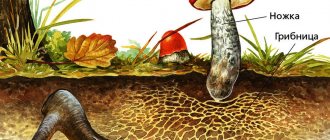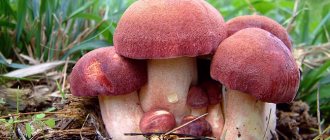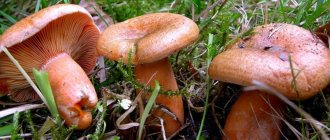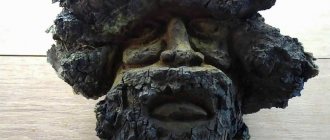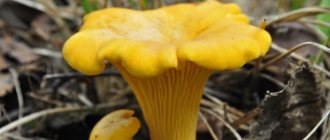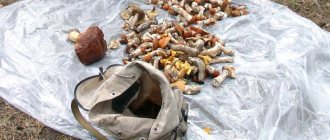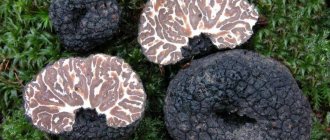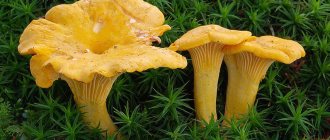The false chanterelle is a representative of the Hygrophoropsis family, often found in the forests of the Northern Hemisphere of the planet and also called the orange talker. There are only slight similarities between real chanterelles (cockerels) and false chanterelles (kokoshkas), but an inexperienced mushroom picker can put both the first and the second in the basket. Therefore, the question of how to distinguish false specimens from edible ones worries many people who like to eat forest products.
First of all, you need to remember that even if several talkers end up in the basket with edible mushrooms, you should not worry. Because, knowing how to distinguish false chanterelles from real ones, you will be able to get rid of unwanted specimens by cleaning and processing them.
Despite the fact that the surface of the talker mushroom is the same color as the cap of edible specimens, otherwise the mushrooms have different features.
Types of edible chanterelles
All eukaryotes included in the genus Chanterelle of the Chanterelle family are edible. More than a dozen species of them grow on the planet. The most common one in Russia is the common (true) chanterelle. In addition, representatives of the genus are tubular (funnel-shaped), gray, etc.
Regardless of whether a person likes to pick mushrooms or not, it is not difficult to find chanterelles, since in the overwhelming majority of cases they grow in entire clearings.
At the same time, some lovers of forest gifts note that among the cockerels there were also talkers, which, at first glance, were no different from the edible species.
Definitioner
Basidia (Basidia) Lat.
Basidia. A specialized structure of sexual reproduction in fungi, unique to basidiomycetes. Basidia are terminal (end) elements of hyphae of various shapes and sizes, on which spores develop exogenously (outside). Basidia vary in structure and method of attachment to hyphae.
Based on the position relative to the axis of the hyphae to which they are attached, three types of basidia are distinguished:
Apical basidia are formed from the terminal cell of the hypha and are located parallel to its axis.
Pleurobasidia are formed from lateral processes and are located perpendicular to the axis of the hypha, which continues to grow and can form new processes with basidia.
Subbasidia are formed from a lateral process turned perpendicular to the hyphal axis, which stops growing after the formation of one basidium.
Based on morphology:
Holobasidia are single-celled basidia, not divided by septa (see Fig. A, D).
Phragmobasidia are divided by transverse or vertical septa, usually into four cells (see Fig. B, C).
By type of development:
The heterobasidium consists of two parts - the hypobasidium and the epibasidium developing from it, with septations (see Fig. C, B) or without them (see Fig. D).
Homobasidia is not divided into hypo- and epibasidia and in all cases is considered to be holobasidium (Fig. A).
The basidium is the site of karyogamy, meiosis, and the formation of basidiospores. Homobasidy, as a rule, is not functionally divided, and meiosis follows karyogamy. However, the basidia can be divided into probasidium, the site of karyogamy, and metabasidium, the site of meiosis. Probasidium is often a resting spore, for example in rust fungi. In such cases, the probasidium germinates into a metabasidium, in which meiosis occurs and on which basidiospores are formed (see Fig. E).
See Karyogamy, Meiosis, Hypha.
Pileipellis
Lat. Pileipellis, skin - a differentiated surface layer of the cap of agaricoid basidiomycetes. The structure of the skin in most cases differs from the inner flesh of the cap and may have a different structure. The structural features of pileipellis are often used as diagnostic characters in descriptions of fungal species.
Based on their structure, they are divided into four main types: cutis, trichoderma, hymeniderma and epithelium.
See Agaricoid fungi, Basidiomycete, Cutis, Trichoderma, Hymeniderma, Epithelium.
Kutis
The type of cap skin consists of creeping, ungelatinized hyphae located parallel to the surface. The surface of the cap looks smooth.
Lat. Cutis.
See Hypha.
Where do false chanterelles grow?
False chanterelle mushrooms can be found in forests of various types. They can grow in the same places as cockerels: in pine forests and spruce forests, in deciduous groves and in dead wood. Orange talkers are most common in small-leaved and mossy coniferous plantations, characterized by an abundance of rotting and old trees.
Both real and false chanterelles love water and coolness, so they can often be found under leaves or fallen trees, at the base of old stumps.
The peak of fruiting of false eukaryotes, depending on weather conditions, occurs in August - September. Ordinary edible mushrooms are capable of bearing fruit until stable frost sets in.
Distribution and collection
Yellow hedgehog is distributed throughout Eurasia and North America, in the temperate and cold zones. Prefers well-lit birch forests and mixed forests. In Russia it is found all the way to Siberia and the Far East.
It grows singly and in groups, sometimes large, in which the mushrooms grow together with both stems and caps. Often forms “witch rings” - concentric circles and semicircles, along the border of which mushrooms grow.
Hydnum emarginate.
The growing season is from July to October.
Comparison of real and false chanterelles
Every lover of collecting forest gifts should know what a false chanterelle looks like. To determine the differences, it is necessary to familiarize yourself in detail with each type.
Varieties of chanterelles such as tubular, gray, white and others do not have doubles, but the common cockerel can be confused with the orange talker.
The fox is real
False fox
Despite the fact that edible and false specimens are very similar, an experienced mushroom picker can easily distinguish them from each other.
This is where simple advice from an experienced forest lover comes in handy. Even though these are delicious mushrooms, you should remember that they have doppelgängers.
I’ll tell you how I identify chanterelles: you can focus on the color of their caps and the shape of their legs. Thus, everyone’s favorite cockerels are distinguished by their muted reddish color.
The surface of their cap is matte, always smooth, the skin is almost inseparable from the pulp - thick, juicy, matching the shade of the stem. Sometimes the flesh of the mushroom can be very light, almost white. When broken and pressed, it turns slightly red.
The edges of the cap when young are smooth and neatly rounded. As they grow, they curve beautifully, become wavy at the edges, and the fruiting body takes on a slightly funnel-shaped shape with a recessed center.
The real chanterelle is capable of growing to a large size. Often there are specimens with a cap diameter of about 10-12 cm.
Chanterelle mushrooms have a thick and strong stem. It expands at the top and smoothly passes into the cap. The color of the fruiting body does not change throughout its entire length and is uniform. The thickness of the leg is from 10 to 30 mm, the length is up to 7 cm. It is slightly lighter than the cap.
Cockerels do not have plates; the hymenophore consists of frequent, highly branched folds that descend onto the stalk, forming one whole with it.
The color of the false chanterelle's caps is brighter than that of real ones. So, when collecting gifts from the forest, a mushroom picker should be alerted by the yellow or orange, slightly velvety surface of the specimen encountered. The diameter of the cap of the cocoshka does not exceed 6 cm, the plates descend onto the stem. They are frequent, thin, bright. The pulp is white or yellow, with a pungent mushroom odor (if the aroma is sweetish, this also indicates that the specimen belongs to the Hygrophoropsis genus).
The pronounced difference between these mushrooms is that they have a rather thin (up to 10 mm) and long (up to 5 cm) stalk. It is smooth, but can rarely be curved.
The inside is fibrous, with pulp resembling cotton wool. The color of the flesh of the stem does not match the shade of the cap; at the base it is darker (almost black).
Key differences
So, you need to remember the difference between the representatives of the two types of eukaryotes. They are the following:
- False chanterelles have a brighter color. Cockerels have a calm reddish tone.
- If the mushroom has a sour taste, and its stem is thick and smoothly turns into a cap, then it is an ordinary chanterelle. This mushroom has a slightly curved stem shape. Kokoshki have a thin and hollow stem.
- The chanterelle mushroom grows in large colonies, while the coco mushroom grows almost always in single specimens. It can be found on fallen and rotting tree trunks.
- All kinds of worms and larvae love to eat false chanterelles, while cockerels are extremely rarely spoiled by insects. The only worm that can be found when cutting the fruiting body of a betta is the wireworm. This fact is explained by the presence of a large amount of chitinmannose in the fruiting bodies of common chanterelles.
- Another difference is that false eukaryotes have an easily removable skin. When it is removed, the rough surface of the cap is exposed. It is almost impossible to remove the skin of cockerels.
- In orange talkers, the color of the plates is brighter than the tone of the cap, while in cockerels it is uniform and the same over the entire surface.
These are the main characteristics that show how one species differs from another.
Description of false chanterelles
A species of mushroom called “false chanterelle” does not exist in nature. The term "false" is applied to similar species of fungi in relation to a specific member of the fungal kingdom.
On a note! The term “false chanterelles” refers to specific mushroom species that have pronounced similarities to chanterelles.
The most common name for the false fox is the orange talker. But in some regions this definition also applies to other forest species, such as the yellow bramble. Chanterelles can also be confused with some representatives of the genus of poisonous mushrooms Omphalotes, of the Negniumaceae family. But most often in mycological reference books only talker and hedgehog are listed as doubles of red mushrooms.
Doubles can reach different sizes, both small and medium. The diameter of their caps varies from 2 to 12 cm, the height of the legs - from 3 to 6 cm. The fruiting bodies are presented in a classic shape, with clear outlines of the cap, stalk, and hymenophore.
The shape of the hats is varied:
- convex;
- flat;
- flat-prostrate;
- depressed-funnel-shaped.
There are even representatives with irregularly shaped hats.
Is it possible to eat false chanterelles?
Some inexperienced mushroom pickers are afraid to collect real chanterelles, explaining this by the presence of their poisonous counterparts in the forest. But you need to know that the orange talker is a conditionally edible mushroom. That is, with proper heat treatment, it does not always cause harm to the body.
According to experts, in order for a person to get minor poisoning, it is necessary to eat a fairly large number of talkers. This is difficult to do, because the false mushroom has an unpleasant taste compared to the real one.
In addition, cocos differ from cockerels and have a specific smell. Therefore, in the process of preparing forest gifts, every housewife will be able to recognize the type of eukaryotes.
Pale Chanterelle (Cantharellus pallens)
Taxonomy:
- Division: Basidiomycota (Basidiomycetes)
- Subdivision: Agaricomycotina (Agaricomycetes)
- Class: Agaricomycetes (Agaricomycetes)
- Subclass: Incertae sedis (indefinite position)
- Order: Cantharellales (Cantharellales)
- Family: Cantharellaceae (chanterelles)
- Genus: Cantharellus (Chantelle)
- Species: Cantharellus pallens (Pale Chanterelle (White Chanterelle))
Synonyms:
White chanterelle
Light chanterelle
Cantharellus cibaruis
The pale chanterelle (lat. Cantharellus pallens ) is a species of yellow chanterelle. The mushroom is also called the light chanterelle , Cantharellus cibaruis var. pallenus Pilat or white chanterelle .
How to avoid chanterelle poisoning
But, according to medical statistics, poisoning by false chanterelles is still possible. In order to avoid this unpleasant condition, you must follow a few simple rules:
- Before eating, heat-treat the collected forest products. This will destroy most of the toxins found in the fruiting bodies of eukaryotes. Even if the chanterelles are real, they are eaten only boiled or fried.
- Carefully ensure that no poisonous mushroom gets into the basket with chanterelles. Otherwise, the entire batch that came into contact with such a specimen may cause illness if consumed.
- Collect chanterelles only in environmentally friendly places, remote from industries and highways. Chanterelles that have absorbed chemical fertilizers, heavy metal salts and other toxic substances can cause poisoning.
- When storing mushrooms for a long period of time, follow all canning rules to avoid the spread of botulism.
- Mark the places where chanterelles grow. If a mushroom with a bright cap is found on a rotting stump or on the trunk of a fallen tree, it is better not to collect it.
- Never store raw or boiled (fried) chanterelles in the refrigerator for a long time. Bacterial spores may get into the product, which, if mushrooms are eaten, will lead to stomach upset.
While on a “quiet hunt,” inexperienced mushroom pickers should carefully examine each specimen, remembering the differences between the false chanterelle and the ordinary one before putting it in the basket.
Chanterelle mushroom drawing. We draw chanterelle mushrooms with a simple pencil. Master class with step-by-step photos
Dina Fomina We draw chanterelle mushrooms with a simple pencil. Master class with step-by-step photos
We draw chanterelles with a simple pencil. Master class with step-by-step photos.
Purpose of the master class: learn to draw mushrooms with a simple pencil
Equipment, materials: simple pencils of varying softness, eraser.
Many people, when taking up a drawing, begin to draw from a certain part of the object (from the face of a person, from the head of an animal). Because of this, the drawing turns out to be disproportionate, shifts in relation to other objects in the drawing, sometimes it can be miscalculated and then the object does not fit entirely on the sheet. To prevent this from happening, you need to remember the rule - we draw from the general to the specific. That is, first the general outline of the object is drawn, its location, and then private details are drawn on top of the general outline. Therefore, first we highlight the general contours of our chanterelles and determine how they will lie in relation to each other. Using this rule, our objects in the drawing will not “scatter” across the sheet in different directions and will be correctly proportioned.
Now you can draw the outline of the mushrooms.
Pay attention to how the folds on the mushroom cap are located
Now let's mark where the shadows on the mushrooms will be located. Our hats cast shadows on our legs. There will also be shadows on the folds and sides of the legs. Shade all the shadows.
A mushroom is not a flat object, so we see a shadow on the edge of its stem
Please note that this shadow is not sharp, it smoothly and imperceptibly moves from darker to lighter. So we apply it with a pencil, increasing the pressure at the edge and loosening it in the middle of the mushroom stem.
This is called a transition.
Now you can draw the contours more clearly and start working on the folds under the mushroom cap. Draw dark lines. Please note that they are not even, of different lengths and shapes, darker under the cap and lighter and barely noticeable at the stem, where they end.
On the convex parts, the folds repeat the round shape of the mushroom.
Strengthen the shadow under the cap.
Ready. Now we draw with random strokes the ground and sticks on the mushroom legs.
Symptoms of poisoning
If chanterelle poisoning occurs, the condition will deteriorate within 30 minutes to 3 hours after eating forest products. Often, symptoms and signs of poisoning appear only the next day.
The period depends on the number of talkers eaten and the time devoted to their processing. A person’s age and the presence of chronic diseases are of great importance.
If the chanterelles turn out to be poisonous, the symptoms of poisoning will be as follows:
- pain in the epigastric region;
- weakness;
- severe nausea;
- repeated vomiting;
- diarrhea (less commonly constipation).
If bacteria enter a thermally processed product, the symptoms will be complemented by an increase in body temperature. The intensity of the symptoms depends both on the toxicity of the fungi and on the type of microbe that caused the disorder.
If botulism occurs, which can masquerade as chanterelle poisoning, the following will appear:
- sudden visual impairment (double vision, fog, blurriness);
- muscle weakness;
- dry mouth.
Eating poisonous mushrooms may be accompanied by increased salivation, sudden jumps in blood pressure, and constriction or dilation of the pupils.
In all cases, seek immediate medical attention.
Despite the benefits and composition, which includes a large number of substances necessary for the human body, real chanterelles and their doubles (false) are considered mushrooms that are difficult to digest. This is explained by the presence of chitin in the pulp of the former, and toxic substances in the latter. Eating even a small amount of this product can cause illness in people suffering from pathologies of the gastrointestinal tract and enzyme deficiency. In severe cases, undigested mushrooms can clog the intestines, which will require urgent medical attention.
First aid for chanterelle poisoning
Even if a person is not afraid of being poisoned by mushrooms and believes that the product was of high quality, if negative symptoms occur after eating chanterelles, it is necessary to call an ambulance.
Before her arrival, the following measures must be taken:
- Perform gastric lavage by drinking 4-5 glasses of warm boiled water and pressing on the root of the tongue with the handle of a spoon to induce vomiting. The procedure is repeated until the vomit becomes transparent.
- Cleanse the intestines with an enema with warm boiled water.
- Drink 10-15 tablets of Activated Carbon, 1 sachet of Enterosorb or 1 tbsp. l. Enterosgel. The latter must be dissolved in half a glass of warm water.
- Take 20 g of a salt-based laxative (Magnesia sulfate, Barbara's salt).
- Drink large quantities of clean drinking water.
In most cases, orange talker poisoning is not severe, and stabilization of the condition can be achieved fairly quickly.
Medicinal properties, benefits and possible harm
Cantharellus cibaruis is widely used in medicine; tinctures, extracts, and powders are prepared from it. It will help remove radiation and worms from the body; when combined with other components, it improves liver function and treats hepatitis C. Mushroom tinctures will help get rid of abscesses, boils and even sore throats.
Regularly consuming light chanterelle can improve vision and reduce weight due to its low calorie content and high protein content. At the same time, medicinal qualities are combined with high taste.
Among the contraindications are:
- pregnancy;
- lactation;
- age up to 3 years;
- diseases of the gastrointestinal tract in the acute stage;
- allergies.
There is no need to collect mushrooms near landfills, industrial enterprises and roads. Old specimens that are overgrown or dried out are not recommended for use. Heat is also a bad period for collecting chanterelles; they can accumulate toxins in their bodies.
Controversy
Both in the scientific world and among ordinary mushroom pickers, opinions differ about the possibility of eating false chanterelle. In some countries, this mushroom is recognized as edible, but is not popular due to its unpleasant taste and mild mushroom smell.
As a result of the research, it was possible to establish that when soaked for a long time in order to remove the toxins contained in the mushroom, the structure of the talker pulp is disrupted and deteriorates.
Most scientists express the opinion that the effort spent on preparing cocos for food, even if all the necessary conditions are met, is pointless.
After all, the risk of indigestion still remains. If you want to pamper yourself with the gifts of the forest, it is better to eat champignon or another mushroom, the quality of which is beyond doubt.
Cooking recipes
The best time for harvesting is considered to be the second day after a rainstorm. If mold appears on the mushroom, it should be thrown away. Chanterelles are soaked in water for 15 minutes, this procedure will remove the bitterness. Then cook, but no more than 10 minutes. Afterwards, you can start preparing dishes: the forest product is fried, stewed, baked, and added to soup.
Chanterelles need to be dried in the sun; to do this, it is enough to clean them of forest contamination and wash them. It's easier to cook in the oven. You can only store them completely dry, otherwise they will become moldy and become unusable.
To freeze, after boiling, just let the mushrooms drain and pack them in sealed bags. Take it out as needed, you can add it to dishes without defrosting, they will thaw during cooking and arrive together with other components.
White chanterelle is a very tasty and healthy mushroom. Unfortunately, it does not occur as often as we would like. Thanks to it, you can reduce the caloric content of your diet without compromising the quality of your diet, and improve your health.
